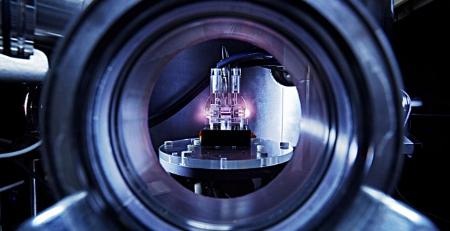EU funds design study for European plasma accelerator
 Three million euros for European Plasma Research Accelerator with eXcellence In Applications (EuPRAXIA) project
Three million euros for European Plasma Research Accelerator with eXcellence In Applications (EuPRAXIA) project
The European Union supports the development of a novel plasma particle accelerator with three million euros from the Horizon2020 program. The EU project EuPRAXIA (European Plasma Research Accelerator with eXcellence In Applications) will produce a design study for a European plasma research accelerator building on work carried out by some of the LA³NET partners. Plasma acceleration promises to shrink costs and size of particle accelerators for science, medical applications and industry significantly.
“EuPRAXIA will define the missing step towards a new generation of plasma accelerators with the potential for dramatically reduced size and cost,” said EuPRAXIA coordinator Ralph Assmann from DESY. “It will ensure that Europe is kept at the forefront of accelerator-based science and applications.” The EuPRAXIA consortium brings together 16 laboratories and universities from five EU member states, including LA³NET partners STFC, LOA, University of Strathclyde, and University of Liverpool. In addition, it includes 18 associated partners from eight countries, involving leading institutes in the EU, Japan, China and the United States.
Plasma acceleration uses electrically charged plasmas, generated by strong lasers, instead of the usual radio frequency used in conventional accelerators, to boost particles like electrons to high energies. The new technology, pioneered at some of the LA³NET participating laboratories, has demonstrated accelerating fields a thousand times beyond those presently used.
By the end of 2019, EuPRAXIA will produce a conceptual design report for the world’s first 5 GeV plasma-based accelerator with industrial beam quality and dedicated user areas. EuPRAXIA is the required intermediate step between proof-of-principle experiments and versatile ultra-compact accelerators for industry, medicine, and research.

Image of a plasma cell. Credit: Heiner Müller-Elsner/DESY
The study will design accelerator technology, laser systems and feedbacks for improving the quality of plasma-accelerated electron beams. Two user areas will be developed for a novel free-electron laser, for high-energy physics and for other applications. An implementation model will be proposed, including a comparative study of possible sites in Europe, a cost estimate and a model for distributed construction but installation at one central site. As a new large research infrastructure, EuPRAXIA would place Europe at the forefront of the development of novel accelerators driven by the world’s most powerful lasers from European industry in the 2020's.
LA³NET partners play a key role in EuPRAXIA. They will contribute to the design of the plasma structures required for a laser-driven electron source, as well as for a laser-driven accelerator stage. Based on previous research they will also study the diagnostics required to monitor the shot-to-shot operation of plasma structures and contribute to the diagnostic of wakefield structures and electron beams. The University of Liverpool will also be in charge of all communication and outreach activities of the design study.
To find out more about the project visit http://www.eupraxia-project.eu.